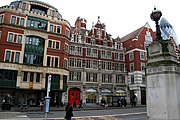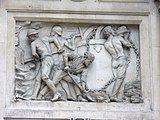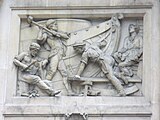world.wikisort.org - United_Kingdom
Bishopsgate was one of the eastern gates in London's former defensive wall. The gate gave its name to the Bishopsgate Ward of the City of London. The ward is traditionally divided into Bishopsgate Within, inside the line wall, and Bishopsgate Without beyond it. Bishopsgate Without is described as part of London's East End.[2]
| Ward of Bishopsgate | |
|---|---|
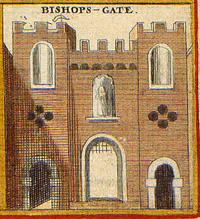 A circa 1650 print of the gate | |
 Bishopsgate ward within the City - after the boundary changes of 1994 and 2003 | |
 Ward of Bishopsgate Location within Greater London | |
| Population | 222 (2011 Census Ward)[1] |
| OS grid reference | TQ330813 |
| Sui generis |
|
| Administrative area | Greater London |
| Region | |
| Country | England |
| Sovereign state | United Kingdom |
| Post town | LONDON |
| Postcode district | EC2 |
| Dialling code | 020 |
| Police | City of London |
| Fire | London |
| Ambulance | London |
| UK Parliament |
|
| London Assembly |
|
The ancient boundaries of the City wards were reviewed in 1994 and 2013, so that the wards no longer correspond very closely to their historic extents. Bishopsgate Without gained a significant part of Shoreditch from the London Borough of Hackney, while nearly all of Bishopsgate Within was transferred to other wards.
Bishopsgate is also the name of the street, being the part of the originally Roman Ermine Street (now the A10) within the traditional extent of the Ward.
The gate
The gate was first built in the Roman era, probably at the time the wall was first built. The road though the gate, Ermine Street, known at this point as Bishopsgate, was in place long before the wall and the gate.
The gate is traditionally held to be named after Earconwald, a 7th-century Bishop of London[3] (Bishop of the East Saxons).[4] One of the ward's ancient churches, St Ethelburga-the-Virgin within Bishopsgate, is dedicated to Eorconwald's sister, St Ethelburga of Barking, the first Abbess of Barking Abbey.
In 1471, during the Wars of the Roses, the Yorkist-turned supporter of the House of Lancaster Bastard Fauconberg attacked London, trying to force his way across London Bridge and also attacking the eastern gates with a further five thousand men and artillery.[5] Bishopsgate was set on fire[6] and the attackers came close to capturing nearby Aldgate and with it the city. The attackers were repulsed from both gates with heavy losses, before being chased back to Bow Bridge and Blackwall.
The Bishop's Gate was rebuilt by the Hansa merchants in 1471 in exchange for steelyard privileges. Its final form was erected in 1735 by the City authorities, but demolished in 1760. This gate often displayed the heads of criminals on spikes. London Wall (which is no longer extant in this sector) divided the ward and road into an intramural portion called Bishopsgate Within and an extramural portion called Bishopsgate Without.
The site of this former gate is marked by a stone bishop's mitre, fixed high upon a building located near Bishopsgate's junction with Wormwood Street, by the gardens there and facing the Heron Tower.
Ward
The ward is notable for its skyscrapers, and is home to the main London offices of several major banks, including National Westminster Bank and the European Bank for Reconstruction and Development. Although tens of thousands of people commute to and work in the ward, it has a resident population of only 222 (2011).[7]
The ward is divided into two parts by the line of the former London Wall and gate which lay just north of Wormwood and Camomile Streets.
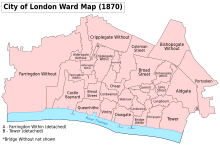
Bishopsgate Without
Bishopsgate Without corresponds to the parish of St Botolph-without-Bishopsgate. The church is located immediately north of the site of the original Gate on the west side of the road. The church was one of four in medieval London dedicated to Saint Botolph or Botwulf, a 7th-century East Anglian saint; three of these were outside city gates, with a fourth near London Bridge and the riverside wharves. The locations result from Botolph being regarded as the patron saint of boundaries, and by extension of trade and travel.[8]
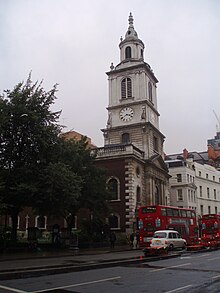
Bishopsgate Without was, from 1247 to 1633, the first home of the Bethlem Royal Hospital (also known as Bedlam). This psychiatric hospital lay immediately north of St Botolph's church. In the 17th century Bishopsgate Without, together with neighbouring Bethnal Green and Spitalfields was home to many Huguenot refugees, many of them weavers.[9]

The former River Walbrook, known at this point as Deepditch, ran along the line of modern Blomfield Street, forming the western boundary of Bishopsgate Without, with the Moorfields (in Coleman Street Ward) beyond it.[10] The Blomfield Street section of the river was the focal point of the Walbrook Skulls; the result of the deposit of large quantities of decapitated Roman-era human skulls into the water.[11] These are still often uncovered during building work.
Notable buildings include:
- Broadgate Tower
- Heron Tower
- Liverpool Street station
- Great Eastern Hotel
- Bishopsgate Institute
- Broadgate Estate
- Dirty Dick's (a 200 year old pub)

Bishopsgate Within
Bishopsgate Within was originally divided into many parishes, each with its own parish church: St Andrew Undershaft, St Ethelburga Bishopsgate, St Martin Outwich, St Mary Axe and St Helen's Bishopsgate, now all amalgamated under the last of these. St Helen's is a historic medieval church and former monastic establishment with many ancient funerary monuments and a stained glass window depicting William Shakespeare — commemorating a very famous former parishioner who lived in the area in the early to mid 1590s.
Notable buildings include:
- 99 Bishopsgate
- 100 Bishopsgate
- Tower 42
- 22 Bishopsgate
Ward boundary changes
The 1994 (City), 2003 and 2013 (ward) boundary revisions made fundamental changes to the ancient boundaries of the Ward. The 1994 changes saw Bishopsgate Without (and with it the City of London) gain a large area from the Shoreditch area of the London Borough of Hackney,[12]
The changes made in 2003 and 2013[Need clarity on these reviews] shifted land between Wards of the city. The effect of this was to transfer nearly all of Bishopsgate Within (except for a small area surrounding the Leathersellers' livery hall) to other wards.[13] The ward previously extended much further south, along the Bishopsgate road and Gracechurch Street. At this time Bishopsgate Without lost a small block of buildings east Blomfield Street to the Broad Street ward.
There were no changes to Bishopsgate's ward boundaries in the 2013 boundary changes.[13]
The revised Ward borders the London Borough of Hackney to the north, it neighbours The Portsoken and the borough of Tower Hamlets in the east. The other neighbours are Aldgate (southeast), Coleman Street (west), Cornhill (south-west), Broad Street and Lime Street (south).
Politics
Bishopsgate is one of 25 wards in the City of London, each electing an Alderman to the Court of Aldermen, and Commoners (the City equivalent of a councillor) to the Court of Common Council of the City of London Corporation. Only electors who are Freemen of the City of London are eligible to stand. On 15 September 2022 the ward elected Kawsar Zaman as its Alderman.[14] He is only the third non-white Alderman in the city's hundreds of years of history, the first British-Bangladeshi ever to hold the office, and the youngest ever elected to the Court of Alderman.
Street
The street called Bishopsgate (formerly Bishopsgate Street), which takes its name from the Gate, is the main thoroughfare of the Ward. It is a stretch of the originally Roman Ermine Street (now the A10) between Gracechurch Street and Norton Folgate,[15] taking the name Bishopsgate only within the historical area the Ward.
Although it takes its name from the gate, the road pre-dates the building of the London Wall which was built in the late second or early third centuries. Ermine Street (sometimes called the Old North Road) connected London to Cambridge, Lincoln, York and other towns and cities.
History
Early history
In the Roman period it was illegal to bury the dead within the city, so cemeteries were established outside the City gates. There were large burial grounds outside Bishopsgate, on both side of Ermine Street.[16]

The Wards of London appear to have taken shape in the 11th century, before the Norman Conquest. Their administrative, judicial and military purpose made them equivalent to Hundreds in the countryside. The primary purpose of Wards like Bishopsgate, which included a gate, appears to be the defence of the gate,[17] as gates were the weakest points in any fortification.

The earliest origins of the Wards reach back further than the 11th century but their emergence and evolution is uncertain and any narrative conjectural.[18] The Ward may have developed from the Soke of Bishopsgate, a set of rights, and possibly land, held by the Bishop of London over an area to the east of the River Walbrook. The Bishop may have been granted the land and rights in order to promote growth in the under-developed part of the city east of the Walbrook. Outside the Wall the Walbrook formed the boundary between the Soke of Bishopsgate to the east and the Soke of Cripplegate on the other side of the brook.[19]
Bishopsgate may have originally included the area that subsequently became known as Lime Street Ward.[20]
The Domesday Survey of 1086 did not cover London, but a landholding called Bishopsgate is recorded nearby, this may have been the property later known as Norton Folgate.[21]
Coaching inns
Bishopsgate had many coaching inns which accommodated passengers setting out on the Old North Road. Although they survived the Great Fire of London, they have now all been demolished. These included the Angel, the Black Bull, the Dolphin, the Flower Pot, the Green Dragon, the Magpie and Punchbowl, the White Hart and the Wrestlers. The Black Bull was a venue for the Queen's Men theatrical troupe in the 16th century.[22] Anthony Bacon moved nearby with his mother in May 1594 and she complained about the plays and interludes at the Bull which might "corrupt his servants".[23]

An inn called the Catherine Wheel (demolished 1911) is commemorated by Catherine Wheel Alley which leads off Bishopsgate to the east.[24] The 17th century façade of Sir Paul Pindar's House on Bishopsgate, demolished to make way for Liverpool Street railway station in 1890, was also preserved and can now be seen in the Victoria and Albert Museum. In the 18th century this grand residence became a tavern called Sir Paul Pindar's Head;[25] another notable venue was the London Tavern (1768-1876). Also demolished (but then re-erected in Chelsea in 1910) was the old Crosby Hall, at one time the residence of Richard III and Thomas More.
Communist Manifesto
The Communist Manifesto was first printed, anonymously and in German, by the Workers Educational Association at 46 Liverpool Street in Bishopsgate Without in 1848.[26]
Terrorist attack
On 24 April 1993 it was the site of an IRA truck bombing which killed journalist Ed Henty, injured over 40 people and caused £1 billion worth of damage,[27] including the destruction of St Ethelburga's church and damage to the NatWest Tower and Liverpool Street station. Police had received a coded warning, but were still evacuating the area at the time of the explosion. The area had already suffered damage from the Baltic Exchange bombing one year before.
St Ethelburgas was rebuilt, functioning not just as a church but also as home to the St Ethelburga's Centre for Reconciliation and Peace charity.
Gallery
- Bishopsgate and the extramural part of Bishopsgate Street, as shown on the "Copperplate" map of London of the 1550s
- The bishop's mitre at Bishopsgate's junction with Wormwood Street
- A former London Fire Brigade station on Bishopsgate (designed by Robert Pearsall), now a supermarket
- The southernmost portion of Bishopsgate pictured in 1955, looking north toward the National Provincial Bank
- Bas relief on the former National Provincial Bank
- From the same building
- Overview of another part of the building
See also
- Fortifications of London
References
- "City of London ward population 2011". Neighbourhood Statistics. Office for National Statistics. Archived from the original on 8 April 2017. Retrieved 16 October 2016.
- Beyond the Tower: a history of East London. by John Marriot. In it refers back to 18th century descriptions of Bishopsgate Without and Shoreditch as EE districts
- Ben Weinreb and Christopher Hibbert (1983) The London Encyclopedia
- On the Diocese of London originally serving the East Saxons "Our History". London Diocesan Board for Schools. 8 February 2021. Retrieved 21 July 2021.
- "Siege of London, 12-15 May 1471". Military History Encyclopedia on the Web. 9 September 2007. Retrieved 21 July 2021.
- Kentish Rising section "The Wars of the Roses – Descriptions of Battles". Richard III Society. Retrieved 21 July 2021.
- "Local statistics - Office for National Statistics". neighbourhood.statistics.gov.uk.
- Churches in the Landscape, p217-221, Richard Morris, ISBN 0-460-04509-1
- Eppie Evans, The Influence of Foreignness, The Influence of 'Foreignness': How Immigration and Imported Commodities affected England https://sas-space.sas.ac.uk/5774/1/Eppie__Evans_-_The_Influence_of_%27Foreignness%27.pdf
- BHO source on the Moorfields area "Historical introduction: Moorfields". British History Online. 21 July 2021. pp. 88–90. Retrieved 21 July 2021.
- London's Hadrianic War? Dominic Perring
- The legislation transferring additional areas to the City of London "The City and London Borough Boundaries Order 1993". legislation.gov.uk. 1 December 1993. Retrieved 21 July 2021.
- City of London Corporation Archived 12 June 2011 at the Wayback Machine Ward boundary review 2010 (final recommendations) – see page 15
- "Election results". City of London. Retrieved 19 September 2022.
- The City of London-a history Borer, M.I.C. : New York, D.McKay Co, 1978 ISBN 0-09-461880-1.
- Descriptions of cemetery site in adjacent Spitalfields gives extensive backgroundSudds, Berni; Douglas, Alistair; Phillpotts, Christopher. "EXCAVATIONS AT CRISPIN STREET, SPITALFIELDS: FROM ROMAN CEMETERY TO POST-MEDIEVAL ARTILLERY GROUND" (PDF). lamas.org.uk. Retrieved 21 July 2021.
- London 800-1216: The Shaping of a City, Brook and Keir Ch 7
- London 800-1216: The Shaping of a City, Brook and Keir. On p156-7 refers to William Pages discussion of the emergence of Wards but asserts the statements while valuable are unavoidably conjectural
- Statements and conjecture passim from London, its origin and early development, William Page, 1923
- London, its origin and early development, William Page, 1923, p176
- See section called A HISTORY OF THE MANOR AND LIBERTY OF NORTON FOLGATE"A HISTORY OF LOCAL GOVERNMENT IN SPITALFIELDS". Spitalfields Forum. Retrieved 21 July 2021.
- Wood 2003: 124-8
- Thomas Birch, Memorials of the Reign of Queen Elizabeth, vol. 1 (London, 1754), p. 173.
- Weinreb and Hibbert 1983: 127)
- Weinreb and Hibbert 1983: 586
- Bosmajian, Haig A. "A RHETORICAL APPROACH TO THE COMMUNIST MANIFESTO" (PDF). dalspace.library.dal.ca. Retrieved 21 July 2021.
- De Baróid, Ciarán (2000). Ballymurphy And The Irish War. Pluto Press. p. 325. ISBN 0-7453-1509-7.
External links
- Ward map from the Corporation of London
- Bishopsgate ward newsletter
- Map of Early Modern London, with scholarly commentary. Bishopsgate is in grid square B6, right side.
- Pubs within the City of London
- Bishopsgate Ward Club
- Michael Wood (2003) In Search of Shakespeare. London: BBC Worldwide.
- Mention in Being for the Benefit of Mr. Kite! by the Beatles: "The celebrated Mr. K. performs his feat on Saturday at Bishopsgate."
- St Helen's Bishopsgate
Другой контент может иметь иную лицензию. Перед использованием материалов сайта WikiSort.org внимательно изучите правила лицензирования конкретных элементов наполнения сайта.
WikiSort.org - проект по пересортировке и дополнению контента Википедии

